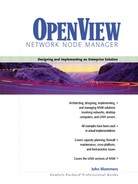Setting the Scope and Conducting a Pilot Test
Before deploying NNM across the enterprise network it is important to build up confidence in the product’s implementation. A pilot test is an excellent and recommended way to build that confidence. Several sites should participate in the pilot test. The pilot users become effective evangelists, or champions, for the NNM tool. They also help bring good success stories and best practices to the table. A successful pilot test should be considered a prerequisite to an enterprise-wide NNM deployment.
The pilot test is a project in itself. The duration of the pilot should be fixed to, say, a few months. Rules for using the NNM systems should be agreed to and followed. For example, all participants in the pilot must be fully NNM trained. User feedback is encouraged (all kinds). Success stories should be shared with the same enthusiasm as children trading Pokemon cards. Lessons will be learned. Weekly conference calls among the pilot participants should be used to keep the project on track and to administer appropriate kudos to outstanding contributors.
During the pilot, you discover what is really attached to the network. You may find to your total amazement that community strings are not always configured consistently in network devices. You may find equipment that has been forgotten or recently installed. You will learn the impact of the SNMP traffic on router CPUs. “Bad” SNMP agents turn up as well. You will also deal with autodiscovery and autolayout challenges.
At the early stages of the pilot test, the discovery filter will be wide open. This is convenient because it corresponds to the NNM default of “no filter at all.” For the purpose of obtaining an inventory of network devices, this is a good first step. You will then configure the discovery filter to limit NNM to discovering just the kinds of devices you are interested in managing, such as routers, switches, bridges, hubs, network printers, servers, and terminal servers. The size of the NNM database will be relatively enormous without the discovery filter, and the system will perform much faster after the filter is applied.
During the pilot the various users will have an opportunity to learn how to best build maps suited to their needs. SNMP data collection and threshold settings can be perfected. Finally, the amount of disk space needed to support the required functionality can be estimated. It will become apparent at this time what system sizing is needed to achieve good response time.
The remote support model can be tested during the pilot to ensure that it can be implemented across the enterprise. Hiccups in remote installs can be ironed out. User convenience scripts may be developed. You can evaluate how long a backup takes, how quickly a map synchronizes, and how responsive the SNMP grapher is for long data collections.
At the end of the pilot test, you will have confidence that victory is at hand.
